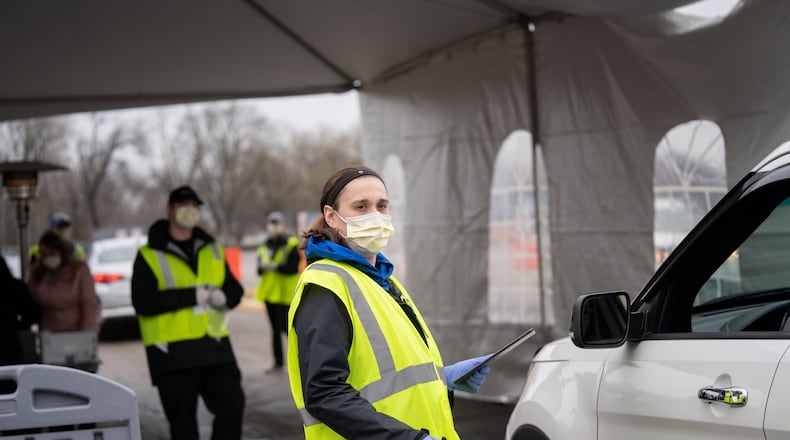But current federal rules prevent the money from being directly used to plug the biggest gap left by the pandemic — the blow to income tax revenue and other sources caused by business shutdowns. Local leaders say shortfalls ranging from 10% to 20% have resulted in cancelled projects, hiring freezes, staff furloughs and other budget cuts.
“It can’t be used for revenue replacement, so it’s not like money that will cover our losses,” said Dayton Mayor Nan Whaley. “But it will allow us to do more work in the community for folks who have been affected by COVID.”
A bill signed last week by Gov. Mike DeWine directed $350 million of Ohio’s portion of the federal Coronavirus Aid, Relief and Economic Security (CARES) Act funds to local governments that were not included in the U.S. Treasury Department’s first allocation that went only to state and county governments with populations above 500,000.
Dayton, the county’s largest municipality, will receive 62.2% of the local relief funds, or $8.2 million of the total $13.2 million. Kettering, Huber Heights, Riverside, Trotwood and Centerville will get the next largest portions of the funds:
- Kettering: $783,000
- Huber Heights: $529,000
- Riverside: $359,000
- Trotwood: $349.000
- Centerville: $340.000
MORE: Dayton-area cities cut millions. Could first responder layoffs be next?
“My office has been preparing to distribute these funds for weeks,” Keith said. “We did not want to make officials in our local communities wait any longer for this important relief funding.”
Montgomery County has already received $92.77 million in CARES Act funding, which will go to small businesses and other programs to support education, agriculture and health care industries, officials said. But none of the money can be used to offset the $29 million in phased budget reductions county commissioners have made through the end of the year.
MORE: Dayton-area small businesses eligible for $40M in relief
As of Thursday, 15 of the jurisdictions had passed a required resolution before the county auditor can release the funds. About 80% of the $13.2 million was set to show up in those accounts Friday, according to the auditor’s office.
“We are ready to distribute these funds to each municipality quickly, as soon as they send us the resolution required to request the funds,” he said.
Dayton city commissioners on Wednesday approved an emergency resolution to receive the funding.
Whaley said she is disappointed that Montgomery County, which was allocated nearly $200 million, is not sharing its funding with cities, unlike in Hamilton and Summit counties.
“The county has not been interested at all in even telling local communities what they are going to do with this money,” she said.
The city of Dayton has made no written request to Montgomery County for funding, said Brianna Wooten, the county’s communications director.
Urban counties across Ohio and the country have borne most of the expense of the COVID crisis as they are the primary providers of social services, said Montgomery County Commissioner Debbie Lieberman.
“So much of the effects of COVID have hit our human services the hardest,” she said. “The extra dollars that we have had to spend, whether it’s food related, or health related, or mental health related, these are all things that the county funds. We are continuously looking at what else we can do.”
The county has started a program for small businesses to apply for grants up to $10,000 to offset pandemic losses. The program has nearly 300 applicants to date, the bulk of which are within the city of Dayton, Lieberman said. The county will soon start a program to help with rent and mortgage assistance to curb evictions, which will also benefit Dayton residents, she said.
Montgomery County has also purchased protective equipment for employees and made changes to facilities to protect workers and the public, expenses eligible under the CARES Act. Commissioners have also provided funds to area homeless shelters and The Foodbank, which could be eligible for reimbursement, according to the county.
State and local governments can use the funds only for unexpected expenditures incurred due to the COVID-19 public health emergency after March 1 of this year.
MORE: Coronavirus: Outbreaks at 13 Montgomery County workplaces
Kettering cut a large number of seasonal jobs, and it relies heavily on income tax collections — some of which it is projecting to lose from the COVID-19 shutdown.
The city is in line to receive about $782,000 to 785,000 in CARES funding, City Manager Mark Schwieterman said.
“It is possible that we will not have $785,000 worth of COVID expenditures. But we are tracking and have been tracking since the onset of the pandemic and will continue to do so,” Schwieterman told Kettering City Council Tuesday night before it approved a measure to accept the CARES Act money.
“There are movements afoot to release and/or modify the treasury regulations to make the expenditures or the revenue available for more than just the expense reimbursement,” he added. “But at this point, it is expense reimbursement for COVID-related items.”
The city’s income tax collections account for 58% of Kettering’s 2020 revenues, records show.
Kettering’s job cuts translate into about 240 summertime positions, down from about 500, Schwieterman has said.
In April, the city announced about 240 part-time employees would either be furloughed or laid off.
More than 90% of the affected part-time workers were in the Parks, Recreation and Cultural Arts Department.
MORE: Miami Valley criminal justice agencies receive $180K in coronavirus funding
The local funds are being distributed in accordance with a formula established by the Montgomery County Budget Commission each year, with the exceptions of local park districts and Montgomery County’s government, which already received funding, according to the auditor’s office.
Once jurisdictions receive their funds, they have until Oct. 15 to spend the money, according to federal guidelines. Any money left unspent by then must be returned to the auditor’s office, which will then redistribute the extra funds to jurisdictions that spent the entirety of their original CARES Act distribution. This redistribution will be proportional to the population of those jurisdictions, according to the auditor’s office.



